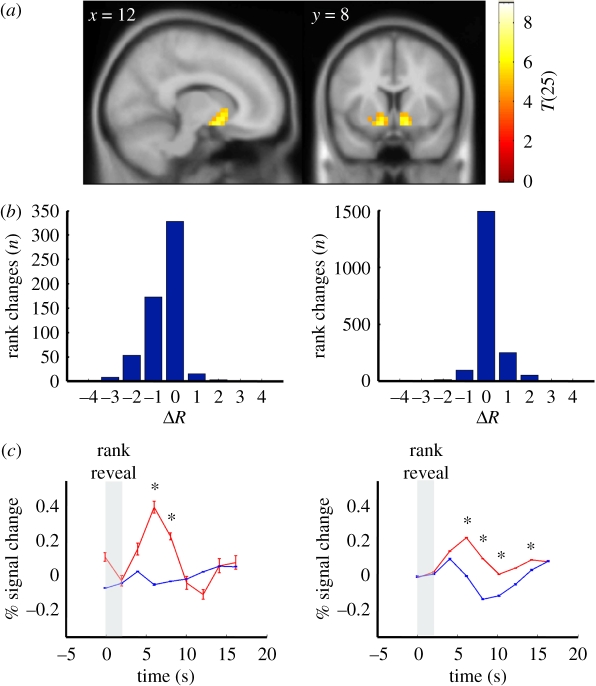Figure 4.
Changes in rank are associated with dynamic responses in the nucleus accumbens that are consistent with a prediction error signal. (a) Nucleus accumbens parametrically responds to positive changes in rank: a random-effects GLM analysis for responses that correlated with parametric changes in rank identified only the bilateral nucleus accumbens for positive changes in rank (random-effects, n = 27, regions with 10 or more voxels significant at p < 0.0001, uncorrected). (b) Positive and negative changes in rank are observed immediately following trials answered correctly or incorrectly: histograms showing the distribution of rank changes following incorrect (left) or correct (right) responses to test questions. Horizontal axis: change in rank (ΔR) following an incorrect answer (left) or a correct answer (right). Vertical axis: number of events (n = 92 trials × 27 scanned subjects = 2484 events, i.e. ‘rank changes’). Rank was calculated based on the performance of the last 10 trials, thus a subject's rank could change following every question and may not follow the performance of the last trial (i.e. an incorrectly answered question could precede an increase in rank (left) or a correctly answered question could be followed by a decrease in rank (right)). (c) BOLD responses in nucleus accumbens to changes in rank following incorrect (left) or correct (right) responses to test questions. Horizontal axis: time (seconds); vertical axis: BOLD response expressed as the percentage change from baseline following the revelation of one's own rank (vertical grey bar); red traces: BOLD responses (mean ± s.e.m.) in the nucleus accumbens associated with rank increases; blue traces: BOLD responses (mean ± s.e.m.) in the nucleus accumbens associated with rank decreases (blue traces). Although subjects did not have explicit feedback about whether they answered the last question correctly or incorrectly the responses observed in the nucleus accumbens are consistent with an expectation error over the effect of answering trials correctly and the effect it should immediately have on one's rank. Asterisk denotes significant difference at corresponding time points between red and blue traces (p < 0.05, **two-sample t-test).

